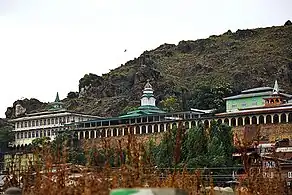Sheikh Hamza Makhdoom | |
|---|---|
حمزہ مُخدوم | |
 | |
| Personal | |
| Born | Hamza Raina 1494 CE (900 AH) |
| Died | 1576 CE (984 AH) |
| Resting place | Hari Parbat, Srinagar, India |
| Religion | Islam |
| Parents |
|
| Era | Shah Mir era |
| Region | Kashmir, India |
| Alma mater | Darul Shifa Madrasa, Shamsi Chak seminary |
| Known for | Sufism |
| Relatives | Ali Raina (brother) |
| Muslim leader | |
| Teacher | Baba Fatehullah, Sheikh Ismail Kabroi |
Students
| |
Influenced by | |
Hamza Makhdoom, popularly known as Makhdoom Sahib (c. 1494 – c. 1576), was a Sufi mystic living in the Kashmir Valley, now in the union territory of Jammu and Kashmir in Northern India.[1][2][3][4] He is sometimes referred to as Mehboob-ul-Alam (literally, "beloved of the world") and Sultan-ul-Arifeen (literally, "king among those who know God").
Early life
Hamza Makhdoom was born as Muhammad Hamza Raina in the village of Tujr Sharif,[5] in the Zainagar block, near Sopore in the Baramulla district of northern Kashmir, then under the Shah Miri Sultanate. He was son of Hazrat Baba Usman Raina and Bibi Maryam, who came from the Raina clan of Kashmiri Pandits who had converted to Islam.[6][1]
According to tradition, teenage Hamza Makhdoom studied in the Shamsi Cha monastery for a year, and later studied jurisprudence, tradition, philosophy, logics, ethics and mysticism in a madrasa founded by Ismail Kubrawi.[1][6]
Teachings
A prolific scholar and spiritual preacher, Hamza Makhdoom adhered to the tradition of Jalaluddin Bukhari.[1] He directed his teachings specifically to the followers of Islam, and under his influence a part of Kashmir's population trully followed the Hanafi jurisprudence . He was staunch follower of Shariah and Sunnah.
Death
He died at an age of 82 in year 1576 (984 AH) in Srinagar.
Nearly fourteen years after his death, king Akbar built a shrine there which was reconstructed during the Afghan rule by Atta Mohammad Khan around 1821 AD.[7] The shrine, located on the southern slope of Hari Parbat Hill and popularly called Makhdoom Sahib and Hazrat Sultan,[8] is an important pilgrimage centre in Kashmir.
Atta Mohammad Khan Barakzai in his honour issued the coins bearing the names of Nur-ud-Din-Rishi and Hamza Makhdoom.[9][10]
See also
References
- ↑ "Makhdoom Sahib". The Nation. 5 February 2020. Retrieved 28 November 2021.
- ↑ Shah, Sayid Ashraf (28 November 2021). My Musings (Part I): Current Events. Ashraf Fazili. p. 261.
- ↑ Safvi, Rana (21 September 2022). In Search of the Divine: Living Histories of Sufism in India. Hachette India. ISBN 978-93-93701-16-9.
- ↑ Raza, Syed Asif (7 October 2021). "Hazrat Makhdoom: Our Great Saint". Greater Kashmir. Archived from the original on 26 November 2023. Retrieved 26 November 2023.
- 1 2 Shah, Sayid Ashraf (28 November 2021). My Musings (Part I): Current Events. CreateSpace. p. 112. Retrieved 26 November 2023.
{{cite book}}: CS1 maint: url-status (link) - ↑ Raza, Syed Asif. "Hazrat Makhdoom: Our Great Saint". Greater Kashmir. Retrieved 1 November 2022.
- ↑ "Makhdoom Sahib in Srinagar". Retrieved 3 January 2015.
- ↑ AHMAD, IQBAL. "The saints on the coins". Greater Kashmir. Retrieved 1 November 2022.
- ↑ "Ata Muhammad Khan Barzakai". www.google.com. Retrieved 1 November 2022.